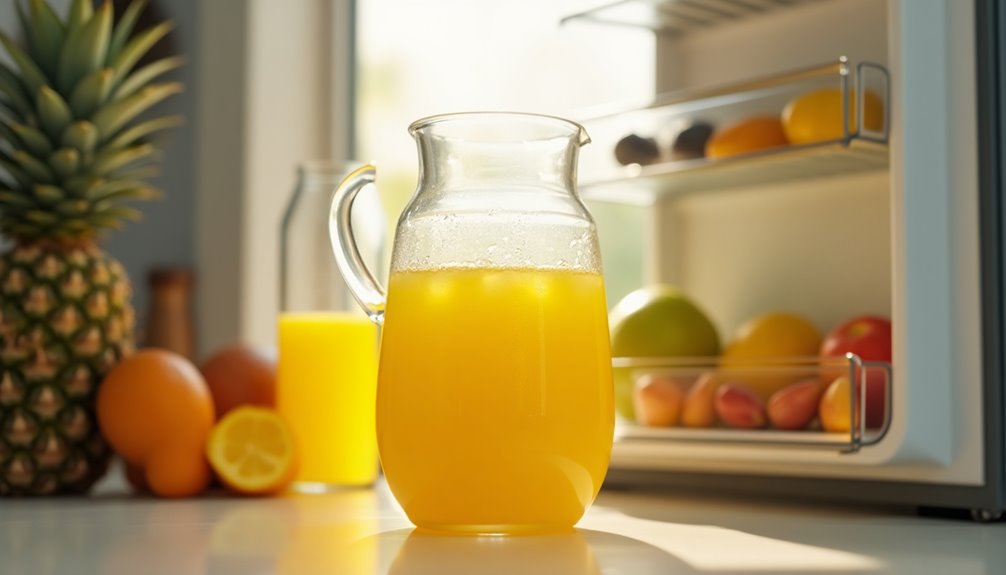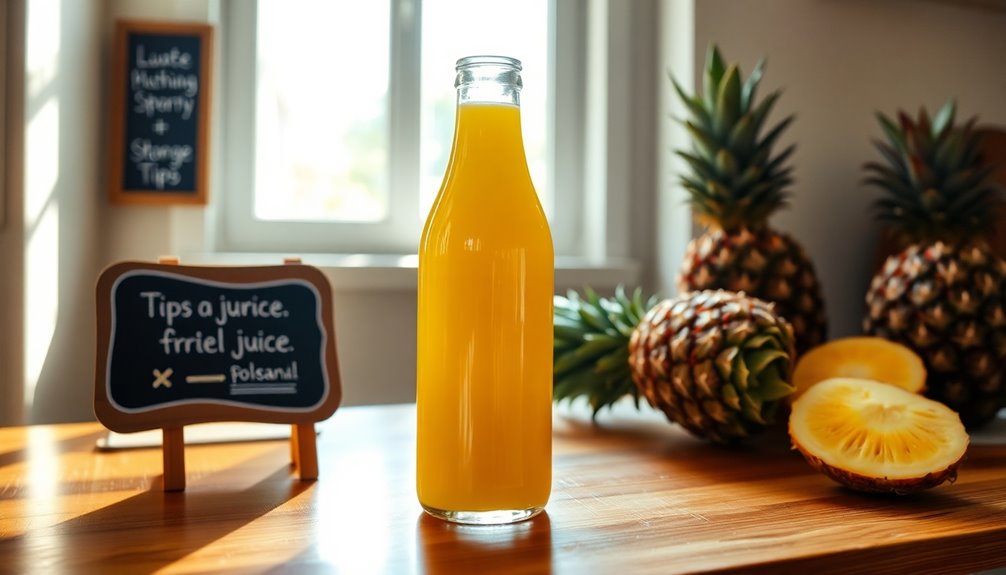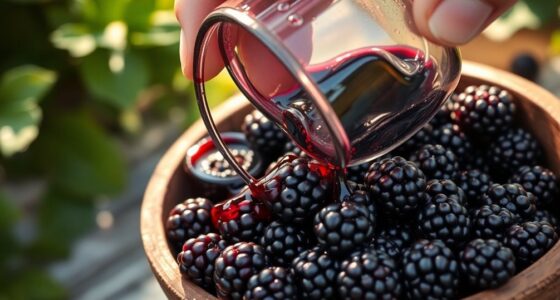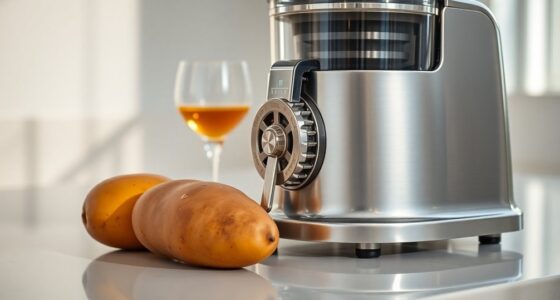Pineapple juice can last about 7 to 10 days in the fridge once it's opened, as long as you store it in an airtight container at a temperature below 39 °F. Be sure to check for any off odors, unusual flavors, or visible mold, as these are signs of spoilage. Keeping the juice fresh is easy with proper storage practices. You'll discover more tips on how to maximize its shelf life and freshness.
Key Takeaways
- Opened pineapple juice lasts about 7 to 10 days when stored properly in the fridge.
- Freshly made pineapple juice only lasts 4 to 5 days in refrigeration.
- Store pineapple juice in an airtight container to maintain freshness and prevent contamination.
- Keep the fridge temperature consistently below 39 °F to extend the juice's shelf life.
- Always check for signs of spoilage, such as off odors, unusual flavors, or visible mold.

When you open a bottle of pineapple juice, you might wonder how long it will stay fresh in your fridge. If you've just cracked open a container, you can expect opened pineapple juice to last about 7 to 10 days when stored properly. Keeping that in mind, it's essential to know how to maintain its freshness and what you should look out for to ensure you're not consuming spoiled juice.
To get the most out of your pineapple juice, it's crucial to practice consistent refrigeration. This means keeping the juice at a temperature below 39 °F. If you can maintain that cool environment, your opened pineapple juice will stay fresh longer. Ideally, you should also store your juice in an airtight container. This helps to keep out any contaminants and prevents the juice from absorbing unwanted odors from your fridge, which could affect its flavor.
While you're enjoying your pineapple juice, be vigilant for signs of spoilage. If you notice off odors, unusual flavors, or even visible mold growth, it's time to toss the juice. Trust your senses; they're usually your best guide. If the juice starts to smell funky or tastes different than when you first opened it, don't take any chances—discard it. Spoiled juice can lead to unpleasant digestive issues, so it's better to be safe than sorry.
If you've gone the extra mile and made fresh pineapple juice, it's worth noting that it has a shorter shelf life. Freshly made cold-pressed pineapple juice typically lasts only 4 to 5 days in the fridge. So, if you've prepared a batch yourself, make sure you consume it within that timeframe to enjoy the full flavors and health benefits.
To extend its shelf life, follow the same storage tips: keep it in an airtight container and ensure your fridge is running at a consistent temperature.
It's also a good idea to keep your pineapple juice away from light and heat sources. Exposure to these elements can degrade the quality of the juice and lead to quicker spoilage.
Frequently Asked Questions
Does Refrigerated Pineapple Juice Go Bad?
Yes, refrigerated pineapple juice can go bad. After opening, you should keep an eye on it for signs of spoilage, like off odors or changes in color.
If you notice any mold or an unusual taste, it's best to toss it out. To maintain quality, make sure you're storing it consistently below 39 °F.
Can Pineapple Last 2 Weeks in the Fridge?
You can't expect pineapple juice to last a full two weeks in the fridge.
It usually degrades in quality after about 7 to 10 days. If you've opened a carton, that juice might start showing signs of spoilage, like off odors or strange flavors, well before the two-week mark.
To keep it fresh, store it in an airtight container and always check for any signs of spoilage before consuming.
How Long Can You Keep Opened Juice in the Fridge?
When it comes to opened juice, think of it like a ticking clock—time's not on your side.
You can typically keep opened juice in the fridge for about 7 to 10 days if you store it properly. Make sure it's in an airtight container and keep the temperature below 39 °F (4 °C).
Always give it a sniff and taste check before sipping to avoid any nasty surprises!
How to Store an Opened Can of Pineapple Juice?
To store an opened can of pineapple juice, you should transfer it to a sealable airtight container immediately.
This prevents exposure to air, which can cause spoilage and off-flavors. Make sure to tightly close the container after each use.
Keep the juice in the fridge, and always check for any signs of spoilage, like off odors or changes in appearance, before you decide to drink it.
Enjoy your refreshing juice!
Conclusion
In conclusion, when stored properly, opened pineapple juice can last about 7 to 10 days in the fridge, while unopened juice can last several months. Remember, "an ounce of prevention is worth a pound of cure." So, always check for signs of spoilage before consuming. By keeping an eye on your juice, you can enjoy its refreshing taste without any worries. Stay savvy and savor every sip while it's fresh!
Cindy thoroughly researches juicing trends, techniques, and recipes to provide readers with practical advice and inspiration. Her writing style is accessible, engaging, and designed to make complex concepts easy to understand. Cindy’s dedication to promoting the advantages of juicing shines through her work, empowering readers to make positive changes in their lives through the simple act of juicing.

















